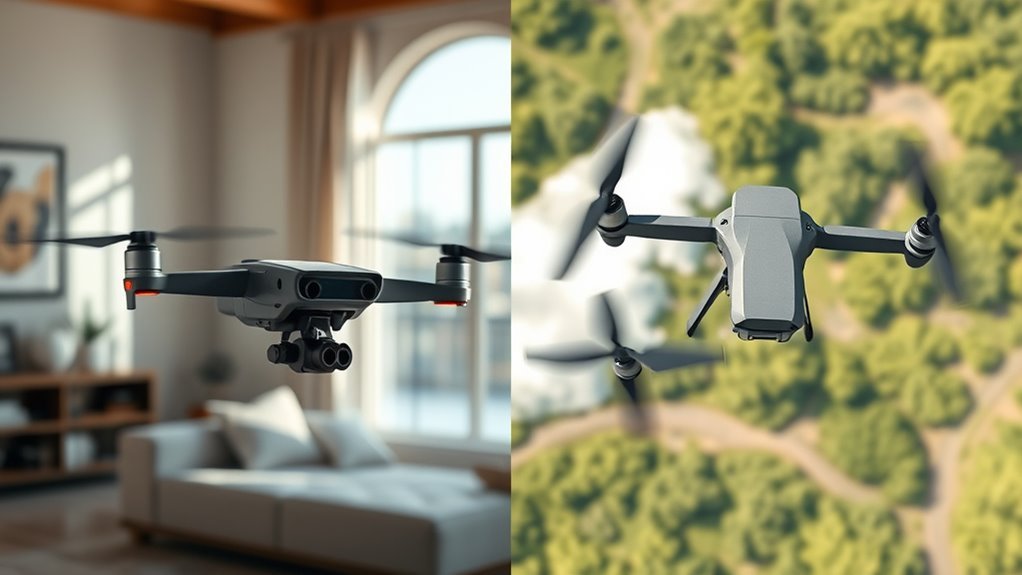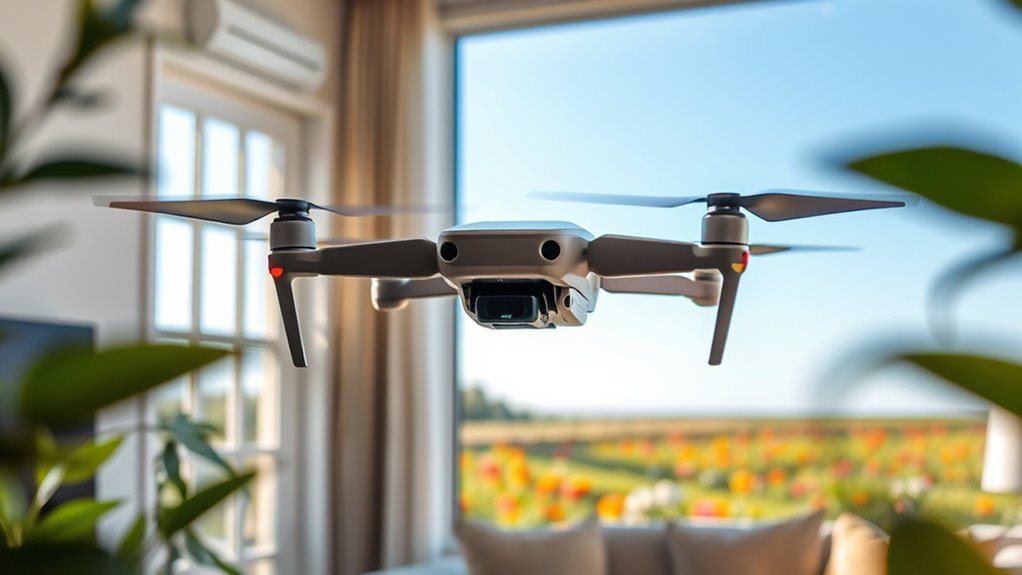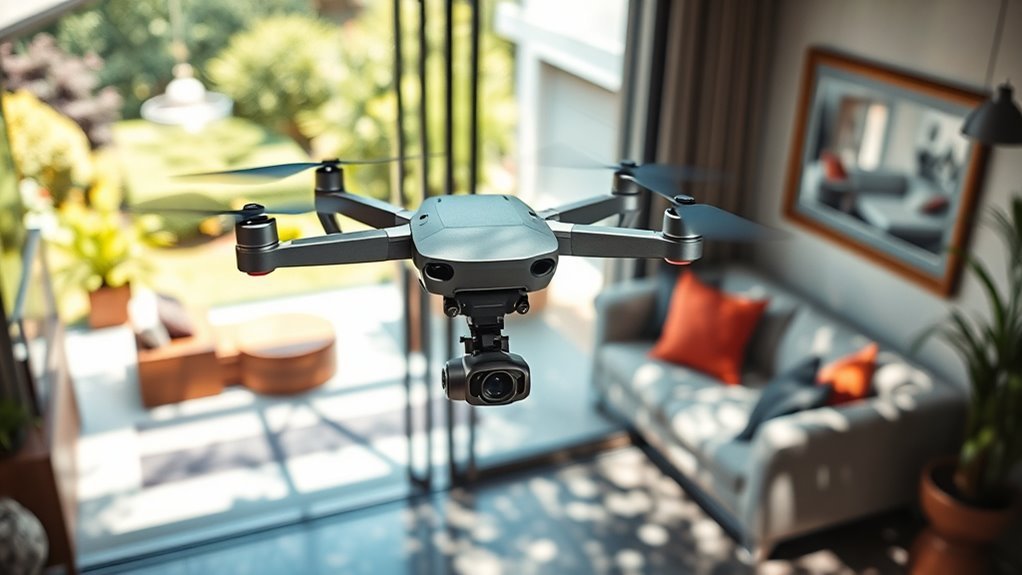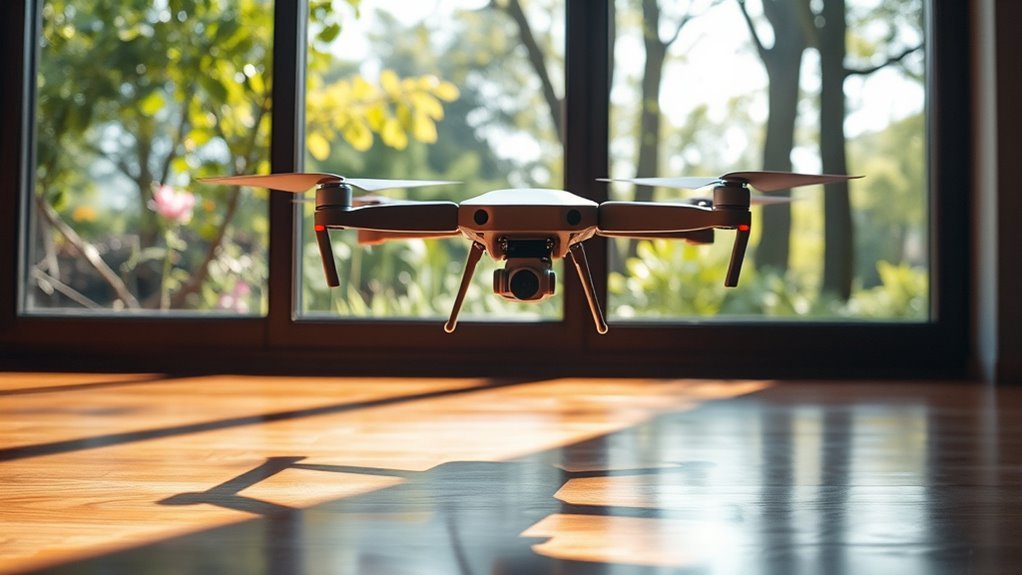When flying a drone inside and outside your house, you need to take into account factors like the type of drone, battery life, and GPS accuracy. Indoor drones require good maneuverability in tight spaces, while outdoor models must handle weather and GPS interference. Safety regulations, noise levels, and obstacle avoidance systems are essential for both settings. Additionally, maintain your drone to guarantee peak performance. Want to discover more about how these aspects interact?
Understanding Drone Types for Indoor and Outdoor Use

When it comes to flying drones, understanding the types suited for indoor and outdoor use is essential for a successful experience. Indoor designs typically feature smaller frames and lightweight materials, allowing for agile maneuvering in tight spaces. These drones often come equipped with protective guards, enhancing safety during flights. Their drone specifications may include features like limited altitude and speed to accommodate indoor environments. In contrast, outdoor drones are generally larger, with robust construction and advanced stabilization systems, capable of withstanding wind and varied weather conditions. They often boast longer flight ranges and enhanced camera capabilities, perfect for capturing breathtaking vistas. Knowing these distinctions helps you choose the right drone, allowing you to explore and enjoy your flying adventures freely. Additionally, outdoor drones like the Dji Mini Drone 3 prioritize advanced stabilization systems for stable flight in challenging conditions, ensuring high-quality camera capabilities that allow for stunning visuals even in less-than-ideal weather.
Battery Life and Flight Time Considerations

While you might be enthusiastic to take to the skies, understanding battery life and flight time is vital for maximizing your drone experience. Effective battery management is important; knowing your drone’s specific flight duration helps you plan your adventures. Most consumer drones offer around 20-30 minutes of flight time per charge, but this can vary based on weight, speed, and environmental factors. Employing good charging techniques, like using the manufacturer’s charger and avoiding overcharging, can greatly extend battery lifespan. Always keep spare batteries on hand for longer flights, and consider investing in a multi-charger for efficiency. By mastering these aspects, you’ll guarantee that your drone stays airborne longer, allowing you to explore freely without interruption. Additionally, the Astro Prime’s battery life is particularly noteworthy, delivering 35 minutes of flight time compared to many consumer models. The high-capacity lithium-polymer battery design featured in advanced drones like the XG Neith ensures stable power output and extended flight times.
GPS Signal Strength and Navigation Challenges

When flying your drone, understanding GPS signal strength is vital for effective navigation. Indoor environments often limit GPS accuracy due to signal obstruction, while outdoor flights can face interference from buildings or natural obstacles. These factors can greatly affect your navigation system’s performance, making it essential to be aware of these challenges before taking off.
Indoor GPS Limitations
Although GPS technology has revolutionized outdoor navigation, its effectiveness diminishes considerably indoors due to various environmental factors. When you’re flying a drone inside, you might face challenges like poor signal strength and reduced GPS accuracy. Walls, furniture, and electronic interference can all disrupt the satellite signals your drone relies on.
| Challenge | Impact on Navigation | Solutions |
|---|---|---|
| Weak Signal | Erratic positioning | Use visual markers |
| Multi-path Errors | Inaccurate location | Implement indoor GPS alternatives |
| Interference | Loss of control | Limit electronic devices nearby |
| Limited Satellites | Navigation failure | Use drone with advanced sensors |
Navigating indoors requires alternative strategies to maintain control and achieve precision.
Outdoor Signal Interference
As you take your drone outdoors, you’ll quickly notice that GPS signal interference can pose significant challenges to navigation. Various interference sources can lead to signal degradation, making it difficult for your drone to maintain a stable flight path. Understanding these factors is essential for a smooth outdoor experience.
- Tall buildings blocking signals
- Dense trees obstructing line-of-sight
- Radio frequency interference from nearby devices
- Weather conditions like heavy rain or storms
- Urban environments with multiple signal reflections
Being aware of these challenges can empower you to choose the best flying locations, ensuring your freedom to explore the skies. Stay vigilant and adapt your flight plans to mitigate potential disruptions for an exhilarating drone experience.
Navigation System Accuracy
While you’re piloting a drone, the accuracy of its navigation system largely hinges on GPS signal strength, which can fluctuate due to several factors. Environmental factors like tall buildings, dense trees, and weather conditions can hinder GPS reliability, causing navigation challenges. You might notice your drone drifting or losing connection when flying in urban areas or under heavy foliage. To enhance navigation system reliability, consider flying in open spaces with clear skies and minimal obstructions. Additionally, using drones equipped with advanced sensors can help mitigate GPS issues, providing altimeter and visual positioning support. Always stay aware of your surroundings, as these factors can noticeably impact your drone’s performance and your overall flying experience.
Safety Regulations for Indoor and Outdoor Flying
Here are some key considerations:
- Indoor regulations often require you to maintain minimal altitude.
- Outdoor restrictions usually mandate flying below specific heights.
- Always avoid crowded areas and private properties.
- Confirm your drone is registered if required.
- Familiarize yourself with local laws and restrictions.
- Additionally, understanding local drone regulations is crucial for safe flying in both environments. Awareness of drone surveillance mechanisms can also enhance your understanding of privacy protection while flying.
Obstacle Avoidance Systems and Their Importance
Understanding safety regulations is just one aspect of responsible drone flying; incorporating advanced technology like obstacle avoidance systems can greatly enhance your flying experience. These systems utilize sophisticated sensor technology to detect obstacles in your drone’s flight path, ensuring collision prevention and reducing the risk of crashes. By employing ultrasonic, infrared, or visual sensors, your drone can autonomously navigate around barriers, whether you’re flying indoors or outdoors. This not only protects your equipment but also fosters confidence in your flying abilities. With obstacle avoidance systems, you’re free to explore more challenging environments without the constant worry of collisions, allowing you to enjoy a more liberating and adventurous drone experience. Embracing this technology is essential for any serious drone enthusiast.
Weather Conditions Impacting Outdoor Flights
As you prepare for an outdoor drone flight, it is crucial to take into account how weather conditions can greatly impact your experience and safety. Factors like wind resistance and temperature fluctuations can affect your drone’s performance and stability. Before you take off, consider the following:
- Sudden gusts can cause loss of control.
- Extreme heat may lead to battery failure.
- Cold temperatures can reduce flight time.
- Rain can damage sensitive electronics, as environmental factors like heavy rain can also impair radar detection capabilities.
- Low visibility can hinder navigation. Additionally, environmental conditions such as wind and temperature extremes can significantly influence your drone’s efficiency and battery life.
Space and Size Limitations in Indoor Environments
Flying a drone indoors presents its own set of challenges, particularly related to space and size limitations. In confined environments, you’ll face limited maneuverability, making it difficult to navigate tight corners and avoid obstacles. This requires heightened spatial awareness; you must constantly assess your surroundings to prevent collisions with furniture, walls, or people. Furthermore, the size of your drone plays an essential role; smaller drones may offer better agility in limited spaces, but they can also lack stability. Understanding the dimensions of your room and the drone’s capabilities will help you maximize your flying experience indoors. Ultimately, mastering these spatial dynamics can provide you with the freedom to explore your indoor environment safely and effectively.
Noise Levels and Considerations for Indoor Flying
When flying a drone indoors, noise levels become an essential factor to take into account. The sound emission from the drone’s rotors can greatly impact the acoustic environment, potentially causing disturbances in enclosed spaces. You’ll need to assess both the drone’s noise profile and the sensitivity of the environment to guarantee a smooth flying experience.
Sound Emission Factors
Drones generate varying noise levels that can markedly affect indoor flying experiences. The sound frequency produced is essential, as higher frequencies often lead to more audible noise that can disrupt your peace. To guarantee a smooth indoor experience, consider noise reduction options, like quieter propellers or specialized drone designs.
- The thrill of freedom can be overshadowed by unwanted noise.
- A peaceful home environment enhances your flying enjoyment.
- You want to escape the chaos, not invite it in.
- The joy of flight shouldn’t come with a soundtrack of disturbance.
- Finding the right balance between performance and sound is key.
Acoustic Environment Impact
Although many enthusiasts relish the excitement of indoor drone flying, the acoustic environment plays an essential role in shaping that experience. Noise pollution can quickly become a concern, especially in confined spaces. Drones emit sound at various acoustic frequencies, which can be jarring in quiet homes. The whirring of blades and the hum of motors can disrupt conversations or disturb others in the household. To enjoy your freedom to fly indoors, consider the drone’s noise levels and how they might affect your environment. Opting for quieter models or employing soundproofing techniques can mitigate negative impacts. Balancing your flying passion with awareness of noise pollution guarantees a more harmonious indoor experience for everyone involved.
Maintenance and Care for Drones After Indoor and Outdoor Use
Proper maintenance and care for your drone after indoor and outdoor use is essential to guarantee its longevity and peak performance. Regular drone cleaning and thorough propeller inspection can make a significant difference in how well your drone performs on future flights.
- Feel the thrill of flying without worry.
- Extend your drone’s life for endless adventures.
- Enjoy peace of mind with every flight.
- Experience the freedom of capturing stunning views.
- Revel in the joy of hassle-free operation.
After each use, wipe down the body and lenses to remove dust and debris. Check the propellers for any signs of damage, and replace them if needed. These simple steps can keep your drone soaring high and performing at its best. Additionally, regular inspections help identify parts needing attention or replacement, which is crucial for preserving mechanical health and operational freedom. Drones like the Lucid Sanitization Drone offer advanced features that can enhance your cleaning efficiency and ensure thorough sanitization during operation.
Frequently Asked Questions
Can I Fly My Drone in My Backyard Legally?
If you’re thinking of flying your drone like it’s the Wild West, remember drone regulations vary. Check local laws for backyard restrictions; you don’t want to accidentally cross into no-fly zones or violate privacy rules.
What Is the Best Way to Store My Drone Indoors?
For ideal drone storage indoors, keep it in a cool, dry place, away from direct sunlight. Use a padded case to prevent damage and guarantee indoor safety, protecting your investment from dust and accidental falls.
How Do I Calibrate My Drone for Indoor Flying?
To calibrate your drone for indoor flying, make certain the drone sensors are properly aligned. Conduct the calibration in a clutter-free space to enhance indoor safety, avoiding obstacles that might interfere with your drone’s navigation and stability.
Can Indoor Flying Damage Drone Components Over Time?
Flying indoors can feel like a thrilling adventure, but it can lead to wear and tear. Indoor hazards, like dust and walls, can impact drone maintenance and potentially damage components over time if you’re not careful.
What Indoor Environments Are Best for Drone Flying Practice?
For practicing indoors, look for open spaces like large garages or gymnasiums. Creating obstacle courses can enhance your skills while keeping things fun. Avoid tight areas to prevent crashes and damage to your drone.

